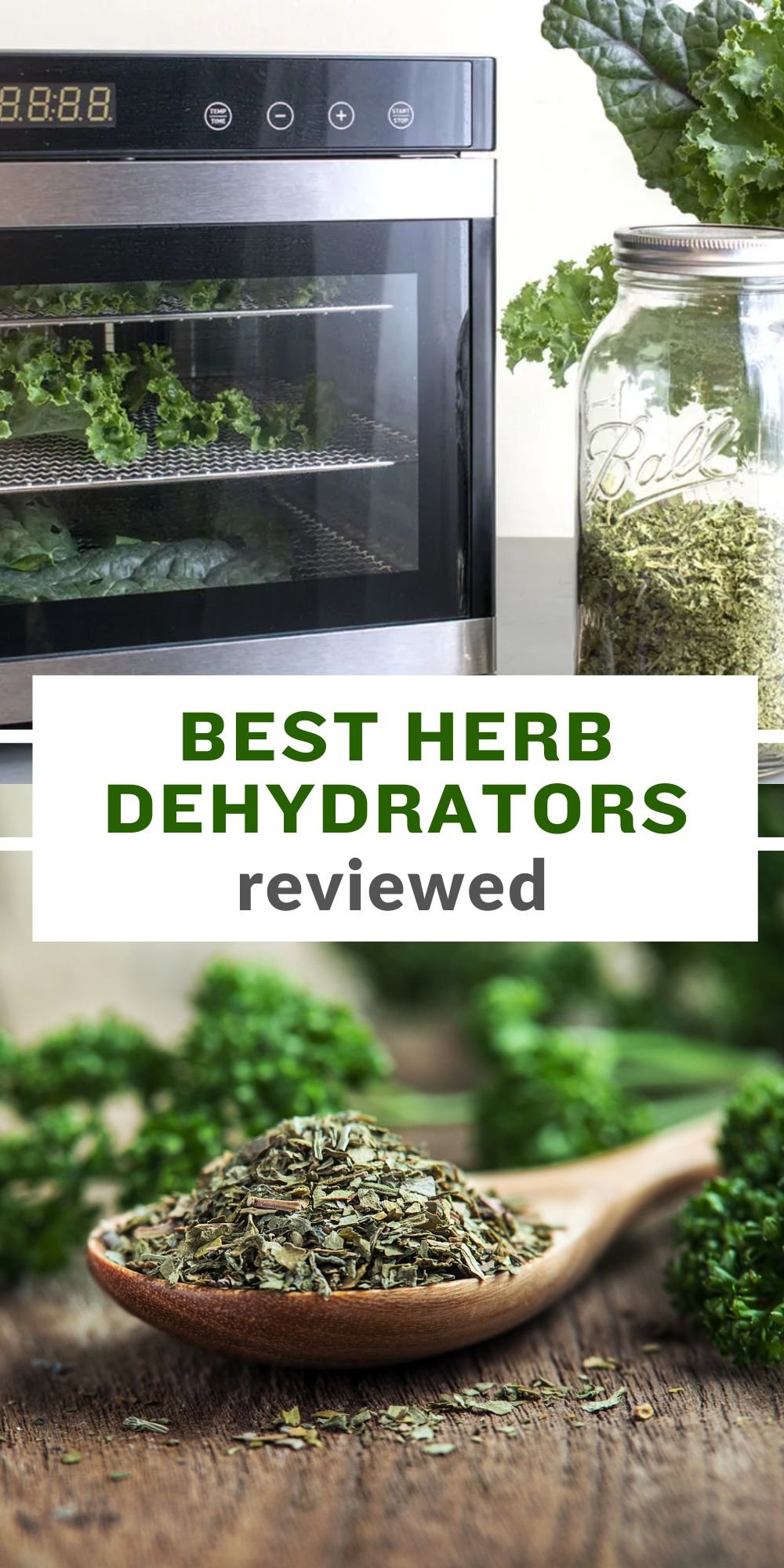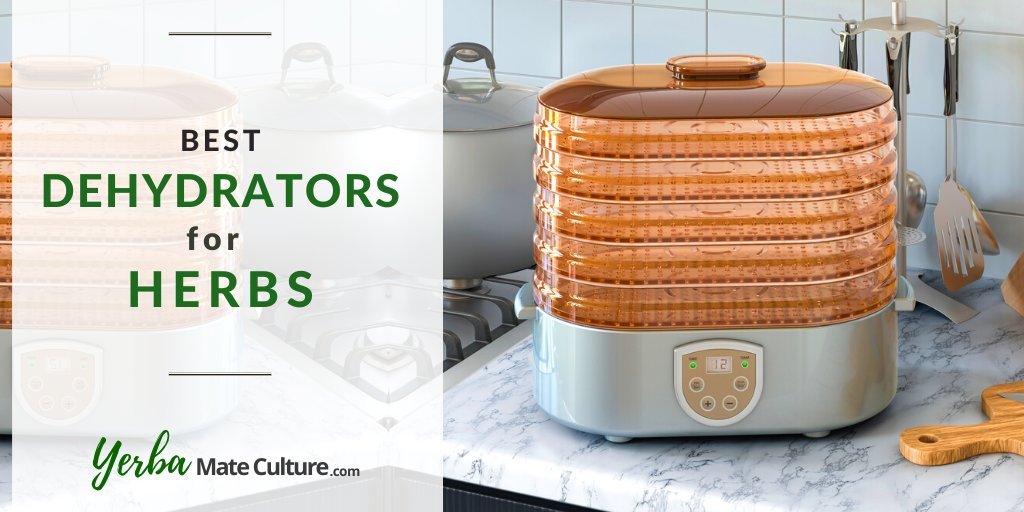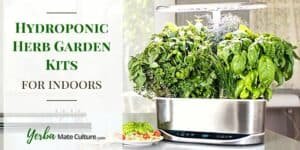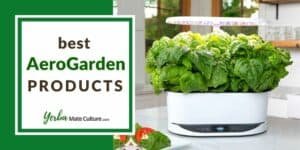You don’t have to pay top dollar for dried herbs and herbal teas — preserve them at home with a food dehydrator for a fraction of the cost. They will be more flavorful and nutritious than supermarket brands, and the process is effortless.
The top-rated herb dehydrators in this guide are not limited to just drying herbs, you can use them to preserve anything from fruits and vegetables to salmon and various types of meat.
Now, let me introduce the best food dehydrators for herbs and explain how to use them properly.
Our recommendations for Best Dehydrators for Herbs:
- Best Box-Type Herb Dehydrator: COSORI Premium Food Dehydrator
- Best Stackable Herb Dehydrator: COSORI Pioneer Food Dehydrator
- Best Portable Option: Brod & Taylor SAHARA Folding Food Dehydrator
- Best Large Food Dehydrator: STX International Dehydra
- Budget Pick: NESCO FD-75A Snackmaster Pro
- Compact & Affordable: Presto Dehydro Electric Food Dehydrator
6 Best Dehydrators for Herbs
Below are our top 5 picks of food dehydrators for herbs. We have included different types of units of various sizes, types, and price options so that you can choose the kind of model that best suits your needs.
All of the units reviewed here, except for the Presto Dehydro, have a temperature control function.
Best Box-Type Herb Dehydrator: COSORI Premium Stainless Steel Food Dehydrator
Our top pick for a box-type model, the COSORI Premium food dehydrator. This model is a potent tool for all herb enthusiasts, gardeners, and culinary aficionados alike, ensuring herbs are systematically dried while preserving their quintessential properties.
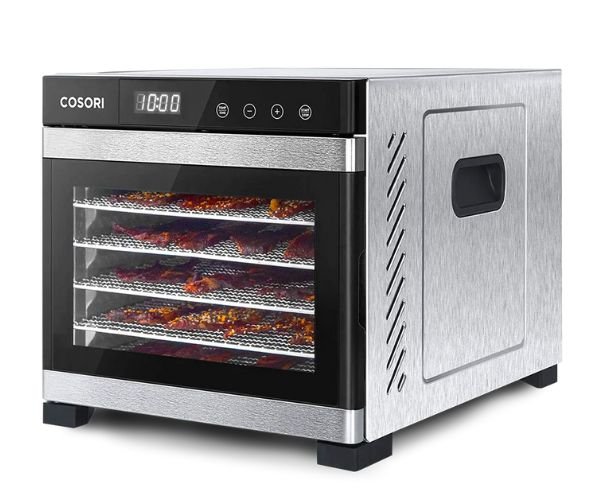
Specifications:
- Power: 600 watts
- Temperature Range: 95°F – 165°F (35°C – 74°C)
- Materials: Stainless steel, glass
- Dimensions: 13.4″ x 17.8″ x 12.4″ (L x W x H)
The COSORI dehydrator showcases a splendid performance in evenly and efficiently dehydrating a myriad of herbs. From basil to mint, the dehydrator preserves the vibrant colors and essential oils, retaining the fresh and aromatic scents so crucial in culinary applications.
The compact box-style design boasts a capable 600-watt heater and a rear-mounted fan for quick but gentle heating.
This food dehydrator comes with six dishwasher-safe stainless steel shelves that provide a maximum of 6.48 square feet of drying space for up to three pounds of herbs, five pounds of jerky, or eight pounds of fruit.
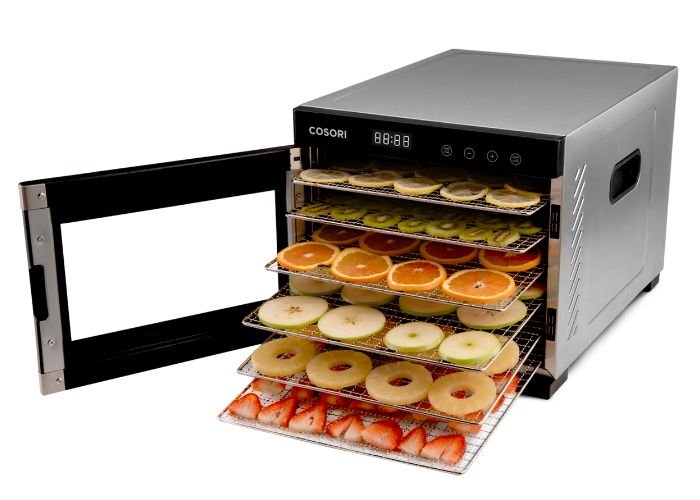
Packed with features, including a 48-hour digital timer with automatic shut-off, it’s effortless to operate, whisper-quiet, and safe. Overheat protection turns the dehydrator off if it malfunctions.
I like the glass door that allows you to observe the food as it transforms from fresh to dehydrated. The included book with 50 custom-created and healthy recipes is also a nice bonus.
Integrated handles make it easy to store if you’re short on counter space, but the stunning black and stainless steel cabinet has an air of quality you’ll want the world to see. Ideal for beginners and experienced herb enthusiasts, COSORI’s premium dehydrator will exceed your expectations.
Pros
- Large drying capacity
- Has a built-in timer
- Made with durable stainless steel and glass
- Stylish design
- Dishwasher safe trays
- Doesn’t make too much noise
- Good safety features
Cons
- Includes only one fruit tray
Best Stackable Herb Dehydrator: COSORI Pioneer Food Dehydrator Machine
Drying herbs is hassle-free with this top-quality stackable dehydrator. The COSORI Pioneer food dehydrator comes with five BPA-free trays plus a fruit roll sheet to make nutritious leathers. Strawberry-basil is a kid-approved combination.
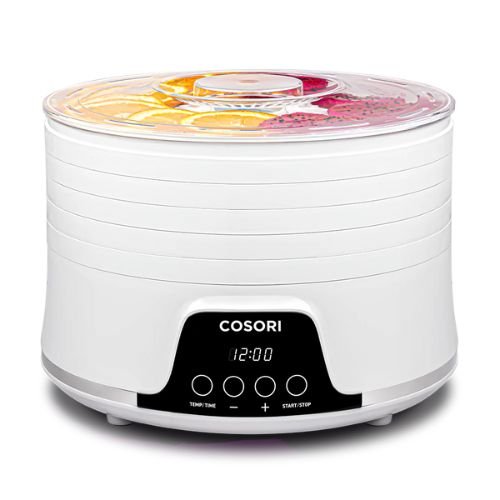
Specifications:
- Power: 450 watts
- Temperature Range: 95°F – 165°F (35°C – 74°C)
- Materials: Plastic (BPA-free)
- Dimensions: 13.8″ x 11.3″ x 13.8″ (L x W x H)
Features include 450 watts of drying power, an intuitive control panel, a 48-hour digital timer with a memory function, and overheat protection. Expandable to seven trays, it assembles and disassembles in seconds for easy cleaning — the trays and lid are dishwasher-safe.
The 13-inch footprint is a space-saver in a studio apartment but could prove small for drying large quantities. For small batches, you won’t find a simpler or more convenient dehydrator on the market.
Pros
- Great value for money
- Easy to use and clean
- Compact and lightweight
- Has a timer
- Safe to use
Cons
- The plastic trays and cover might break over time
- Only one fruit tray is included
Best Portable Option: Brod & Taylor SAHARA Folding Food Dehydrator
Brod & Taylors’s award-winning folding dehydrator is perfect for nomads and small-space living, collapsing to 1/3 of its original size for easy storage and transport.
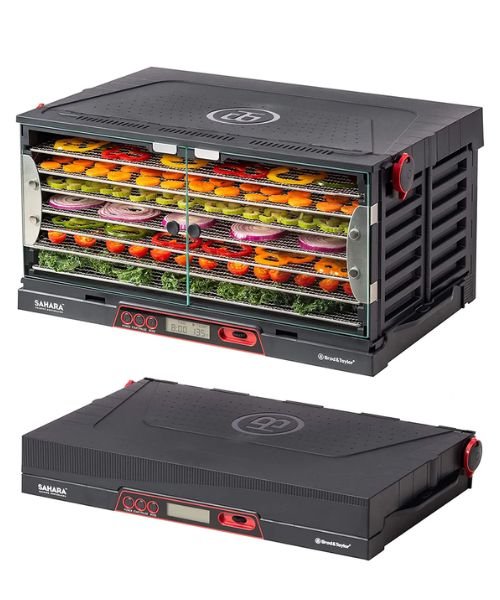
Specifications:
- Power: 750 watts
- Temperature Range: 85°F – 165°F (30°C – 74°C)
- Materials: Stainless steel, glass
- Dimensions (open): 14″ x 22″ x 11″ (L x W x H)
The stainless steel cabinet holds seven trays for as much as 11 square feet of drying area. Dual 700-watt heaters are quiet and efficient, drying plentiful quantities in record time. Two automated timer controls — one for each heater — offer up to 198 hours of continuous operation at 85 – 165 degrees °F.
Watch the drying process through clear glass doors knowing it’s healthy — Brod & Taylor dehydrators feature a washable air filter to keep airborne contaminants out of your food.
This model isn’t cheap, but if you want to dry large volumes in less space, you won’t regret the investment. The SAHARA is a top performer and built to last.
Pros
- Large drying capacity
- Excellent overall quality
- Durable construction
- Portable
- Dual timer and temp control
- Includes an air filter
- 3-year warranty
Cons
- Pricey
Best Large Herb Dehydrator: STX International Dehydra Commercial Grade Food Dehydrator
STX’s commercial dehydrator can stock your herb pantry in hours. Ten 304-grade stainless steel trays offer 11 square feet of drying capacity for treats from beef jerky to the seasonings that make it delicious.
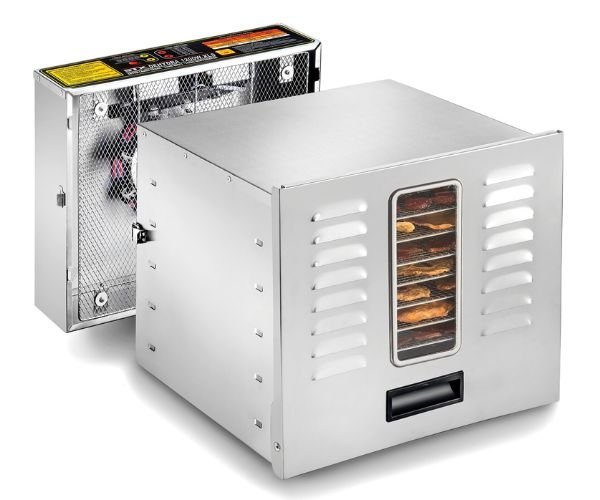
Specifications:
- Power: 1200 watts
- Temperature Range: 97°F – 165°F (36°C – 74°C)
- Materials: Stainless steel, glass
- Dimensions (open): 20″ x 17.5″ x 15″ (L x W x H)
This dehydrator is enormous, measuring 20 × 17.50 × 15 inches, and the powerful 1200-watt heater makes quick work of preserving large volumes of food safely. Equipped with a digital control panel, the Dehydra has seven programmable temperature settings and a 15-hour hour timer plus an automatic shut-off so food won’t over-dry. Cleanup is a breeze with the removable drip tray.
This model has two minor drawbacks. It has an industrial look, so it’s not an appliance most people would want on their counter every day, and at 38 pounds, it’s a bear to move in and out of storage. But if you find it a permanent spot where its aesthetics won’t detract from your décor, it’s a well-appointed, high-volume dehydrator.
Pros
- Huge drying capacity
- Excellent control panel with timer
- Comes apart for easy cleaning
- Made with 304 stainless steel
- Good safety features
Cons
- Not very attractive
- Heavy
Budget Pick: NESCO FD-75A Snackmaster Pro Food Dehydrator
The NESCO FD-75A Snackmaster Pro is a solid contender in the arena of herb dehydrating, meshing affordability with a commendable performance. While it may lack in aspects like noise level and material quality, it robustly holds its ground in providing consistent and even dehydration
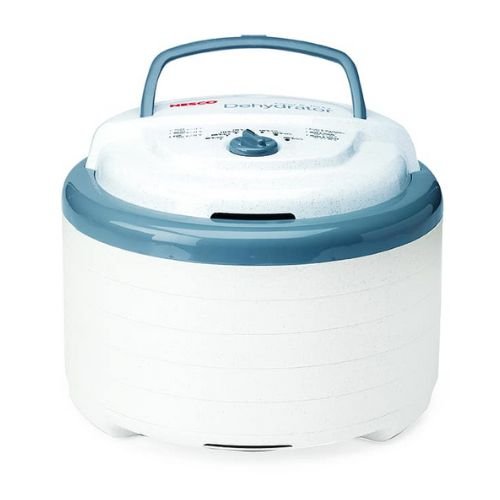
Specifications:
- Power: 600 watts
- Temperature Range: 95°F – 160°F (35°C – 71°C)
- Materials: Plastic (BPA-free)
- Dimensions: 13.75″ x 22.13″ x 13.87″ (L x W x H)
The Snackmasters’ patented Converga-Flow drying system ensures a uniform distribution of heat across all trays, delivering even dehydration of herbs. Offering the potential to expand up to 12 trays, this dehydrator affords a generous space while still being compact and lightweight.
The adjustable thermostat (95°F-160°F) ensures optimal drying temperatures for different herbs, safeguarding their aromatic and nutritional profile. With its intuitive design and straightforward operation, the Snackmaster is a user-friendly device.
This best-selling food dehydrator is a worthy consideration for those embarking on their herb-drying journey, or even more seasoned dehydrators who seek a reliable, cost-effective option.
If the Snackmaster is too small for you, check out the NESCO Gardenmaster Pro for more power and drying space.
Pros
- Great value for money
- User-friendly design
- Easy to clean
- Lightweight
- Made in the USA
Cons
- Not dishwasher safe
- A bit noisy
Compact & Affordable: Presto Dehydro Electric Food Dehydrator
The Presto electric food dehydrator is short on bells and whistles but mighty on performance. It is also very affordable, compact, and has a decent capacity.
Specifications:
- Power: 600 watts
- Temperature Range: 165°F (74°C)
- Materials: Plastic (BPA-free)
- Dimensions: 14.5″ x 15″ x 6.25″ (L x W x H)
Equipped with four BPA-free trays, it’s expandable to eight for drying large volumes. Trays nest for compact storage, and the cord tucks neatly inside.
Despite its bargain price, Presto makes a full range of accessories for the Dehydro, including nonstick mesh screens and silicone liners that keep small herbs like rosemary from falling through the trays.
Our only real disappointment is that it features neither a timer nor an adjustable temperature control. Plug it in, and it heats consistently at 165 degrees — a temperature too harsh for herbs.
Still, some users report adequate results with kitchen favorites from parsley to basil. Presto’s Dehydro electric food dehydrator is proof that good things can come in inexpensive packages.
Pros
- Affordable
- Simple and compact design
- Easy to use
Cons
- Only one temperature setting that is too high for herbs
- No timer
- Noisy
Types of Food Dehydrators
There are two main types of food dehydrators — stackable and box-type. Each has pros and cons.
1. Stackable
Stackable dehydrators are often round and feature trays that nestle atop each other. A fan mounted above or below the trays forces hot air through a center channel, distributing it evenly across each, so food dries uniformly.
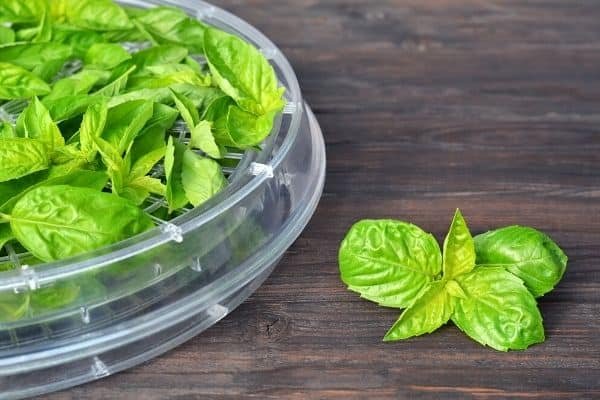
The benefit of this design is flexibility — add or subtract layers to dry herbs in large or small batches. Using only the number of trays you need improves drying efficiency and lowers energy costs.
Disadvantages of stackable dehydrators include the shape — spacing irregularly shaped foods on round surfaces can be challenging — and the materials. The trays are usually made of plastic, so choose only those that are BPA-free. You’ll also have to turn the dehydrator off and unstack trays to check for doneness.
2. Shelf or Box-Type
Box-type dehydrators resemble toaster ovens. The heating element and fan are rear-mounted, circulating air horizontally for even drying. Metal trays slide in and out.
The single disadvantage of box-type dehydrators is that the whole unit has to be heated whether you want to dry two sprigs of rosemary or ten. In areas with high power rates, that can add up with frequent use.
Choosing the Best Dehydrator for Herbs
Drying fresh herbs and other foods is a pleasure with the right dehydrator. Consider how each of these features makes our top picks a good fit for your lifestyle and food preservation needs.
If you are planning on growing your own herbs, I recommend that you also check our guide with the best space-saving vertical garden kits and hydroponic growing systems for indoors.
Temperature Controls
Better dehydrators have adjustable temperature controls to optimize drying for different foods.
Pros recommend dehydrating jerky at 155°F (68°C) but only 95°F (35°C) for herbs. Going over 115°F (46°C) will definitely diminish the aroma and precious nutrients of the plants.
Models that heat at a single consistent temperature are adequate but not ideal. If the temperature is too low, the drying process takes longer and may not remove enough moisture to prevent meats from spoiling. If it’s too high, it can burn tender herbs.
Size and Capacity
A dehydrator’s capacity is measured in square feet. The smallest models offer 3-4 square feet of drying area — large units boast ten or more. While 3-4 square feet sounds impressive, you’ll run out of space quickly if you dry significant quantities. Leafy herbs should be spaced at least an inch apart, so air flows around them unobstructed.
A dehydrator’s size is also a factor to consider — the largest can take up to two square feet of counter space, so measure before you buy. If you plan to keep it in a closet when it’s not in use, consider how much it weighs. Forty-pound models aren’t easy to wrestle in and out of storage.
Timers
Over-drying herbs can compromise their flavor and impart a bitter taste. Dehydrators with timers solve that problem by turning off the unit at a preset time.
Use and Maintenance
Dehydrators aren’t rocket science, but some are more intuitive to operate than others. Better models balance function and convenience.
Features worth paying extra for are back-lit digital screens — they’re a plus for viewing in low-light conditions — and an automatic shut-off switch that shuts down the unit if it overheats. Safety first.
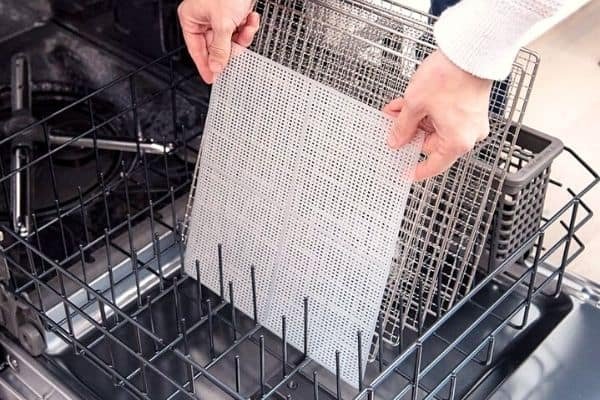
Maintaining a dehydrator is straightforward — just keep it clean. Herbs are rich in natural aromatic oils, so a soap and water scrub after each use prevents plastic trays from absorbing odors. Models with dishwasher-safe trays are a plus.
How to Dry Herbs With a Food Dehydrator
When you have the right kind of food dehydrator, drying your herbs is quite easy. Yet, you should follow these steps for the best result:
- It is best to harvest the herbs early in the morning before it gets hot. You can also use herbs bought from the grocery.
- Prepare the herbs by removing large stems and any damaged parts and then rinsing them carefully under running water. Make sure to remove all dirt and anything else that might be stuck on the surface of leaves and stems. After this, dry the herbs gently between 2 sheets of paper or with a clean towel.
- Preheat the food dehydrator to a temperature of 95°F (35°C). If you are living in an area with high air humidity, you can try higher temperatures, but it is not recommended to exceed 115°F (46°C).
- Place the herbs on the trays of your food dehydrator in a single layer. Make sure that there is enough room for air to circulate around them for an efficient drying process.
- Monitor the herbs frequently while drying them. It usually takes anywhere between 4 to 12 hours to dry them depending on your dehydrator, air humidity, and the type of herbs you are drying.
- The herbs are ready when you can easily crumble them with fingers and the stems snap when you bend them.
- Let the herbs cool down and remove leaves from any remaining stems. Then store them as whole leaves in airtight jars to best preserve them. Large pieces that are hard to put in jars can be gently rubed between your palms or cut smaller. If you prefer, you can crush the herbs later before using them.
Here is an excellent video that shows you how to get it right:
Once you experiment with different herbs and try fine-tuning the temperature, you will learn the exact time and best temperature for each herb. Then you don’t need to monitor them anymore while drying and if the dehydrator has a timer, you can just set it and leave the herbs to dry while going out.
And of course, electric dehydrators offer a great way of making all kinds of snacks from jerky to dried fruits. Dehydrating not only preserves and extends the shelf life of various food items but also brings out new flavors and changes their texture and mouthfeel.
If you are new to using a food dehydrator and want to experiment with different types of foods, I recommend that you choose one of the Cosori dehydrators in this guide. They come with a recipe book that has 50 easy and delicious recipes to get started with.
Herb Dehydrator FAQ
What brand makes the best herb dehydrators?
There are several brands that make high-quality food dehydrators suitable for drying herbs. Some of the most popular and well-known brands include Cosori, Brod & Taylor, and Sahara. To find the best dehydrator for your needs it’s important to look at qualities like size and capacity, temperature range, ease of use, and special features including digital screens and timer functions.
Is it better to dehydrate or air-dry herbs?
Dehydrating herbs is relatively fast and can preserve color and flavor well, but it requires a food dehydrator and uses electricity. Air-drying herbs is energy-efficient and cost-effective, but it takes longer and the final product might be of slightly lower quality. Your choice between the two methods depends on your available resources, time, and specific requirements.
How long does it take to dry herbs with food dehydrator?
Drying herbs in a food dehydrator typically takes between 4 and 12 hours, depending on the type of herb, the quantity and size of the leaves, temperature settings, and ambient humidity.
You can also dry herbs faster with a higher temperature setting but it’s not recommended.
Drying herbs too quickly can have several negative effects:
- Loss of Flavor: The essential oils, which provide the flavor and aroma of the herbs, can evaporate.
- Color Change: Herbs can lose their vibrant color, turning brownish.
- Nutrient Loss: Rapid drying can diminish the nutritional value of the herbs.
- Quality: Overall quality, including texture and taste, can be compromised.
Properly drying herbs slowly and at a lower temperature helps preserve their beneficial properties and quality.
How long do dehydrated herbs last?
Dehydrated herbs can last for up to a year or even longer when stored properly. The key to maximizing their shelf life is to ensure they are stored in a cool, dark place, away from direct sunlight, and in an airtight container to protect them from moisture and oxidation. Over time, however, even properly stored herbs will gradually lose their flavor and potency, so it’s generally recommended to use them within a year for the best quality.
Can you dehydrate different herbs at the same time?
Yes, you can dehydrate different herbs at the same time, but there are a few considerations to keep in mind:
- Similar Drying Times: Try to pair herbs that have similar drying times together so that they finish at approximately the same time.
- Flavor Transfer: Be cautious with herbs that have strong scents or flavors (like mint or rosemary) as they can potentially transfer their flavors to milder herbs if dried together.
- Spacing: Ensure that the herbs are spaced out adequately to allow for good air circulation, which helps in even drying.
Keeping these points in mind will help you successfully dehydrate multiple types of herbs simultaneously without compromising their individual flavors and qualities.
